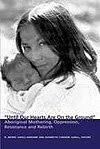Judith Warner’s Perfect Madness: Motherhood in the Age of Anxiety is first and foremost an opinion piece on “the current culture of motherhood” - it should not be taken as sociological or cultural analysis of even the most rudimentary kind.
I liked Miriam Peskowitz’s The Truth Behind the Mommy Wars a lot more for its examination of the work/family/time issues facing American mothers, and Douglas and Michael’s The Mommy Myth for its historical analysis of the media and its influence on modern parenting. Strangely, and very obviously leaving a gaping hole, Warner makes absolutely no mention of Douglas & Michael’s book, even though she covers a lot of the same issues (Peskowitz’s was published close to the same time as Warner’s).
Warner’s book strikes me as sloppy in terms of research, logic and presentation. Her endnotes are not presented in the text of the book, but arranged by page number in the back, so when you want to check the basis for a given statement, you have to turn to the back to see if it is endnoted. Almost every time I did this, I found Warner’s statement was based on a secondary source - a newspaper article or a magazine article usually. Very rarely was any scientific data (even from soft sciences, like sociology, psychology, or anthropology!) cited. For instance, her statement that today’s children display more anxiety, throw more tantrums, behave more disrespectfully, and are just overprotected brats is based on an article from Better Homes & Gardens.
Warner makes some sweeping (and unfounded and just plain inaccurate) generalizations about kid’s food allergies and the use of medication for ADHD & other behavioral problems that are sure to piss off many parents who deal with children with real problems of this nature.
And “Attachment Parenting” - even a middle class watered down version gets given extremely short shrift as just an example of the bad side of over-parenting: “baby-wearing, co-sleeping, long-term breast-feeding and the rest of it — cruelly insensitive to mothers’ needs as adult women”. According to Warner, co-sleeping makes for unhinged, sleep deprived mothers. Funny, everyone I know that co-slept did it because it enabled them to get more sleep.
Some other things that bothered me were the chapters on how this socio-cultural phenomenon that she calls “The Mess” is a personal psychological failing, like bulimia or anorexia, caused by mothers:
1. trying to capture their own idyllic childhoods (repressed overworked mothers & all)
2. trying to compensate for horrible childhoods and neglectful mothers
3. trying above all to gain CONTROL
But then she implies it’s a cultural thing, a mass hysteria, or a cultural OCD where the compulsions include making cupcakes, arranging birthday parties, etc. , and the obsessions are “perfect” children.
My main problem, though, is just with Warner’s basic premise: that the majority of mothers today have this “widespread, choking cocktail of guilt and anxiety and resentment and regret…poisoning motherhood for American women today”. Maybe it’s just her wacko friends and the women (about 150 of them, selected how?) that she interviewed in Washington, D.C.? Do I just live in a small bubble of sanity? Ann Arbor is a relatively wealthy (but too idealistic and activist oriented?) place, and I’m just not seeing this compulsive over-parenting and cult of hyper-motherhood she describes in sometimes hilarious detail.
The sad thing is that I agree with many of the (politically liberal) solutions that Warner proposes that would help American mothers. But this material is tacked onto the next to last chapter, “For a Politics of a Quality of Life”, and hardly given the emphasis or the detail invested in the preceding ten chapters. And Warner completely ignores all of the other people who’ve already called for these changes, making it sound like the solutions are something new and innovative she discovered after she returned from France and discovered a lack of affordable childcare and a bunch of DC area neurotic mothers (not unlike those portrayed in Danielle Crittendon’s Amanda Bright@Home, or perhaps in Desperate Housewives? I need to watch Desperate Housewives). Also, it is hard to see how these laudable structural changes would actually improve “The Mess”, which is supposedly self-imposed, all-encompassing, and inextricably intertwined with our American lifestyle and identities as mothers.







